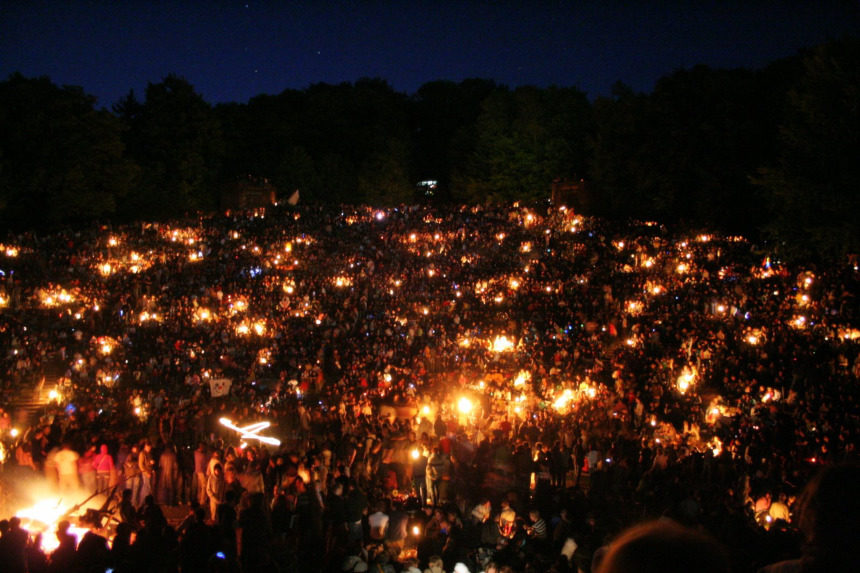Calendar dates can be funny things; any individual day can carry a number of associations for different people, from birthdays to anniversaries, from first jobs to last rites. History has its own version of this, with some dates taking on totemic significance for particular countries; July 4 in the United States, and November 5 — Guy Fawkes Day — in the U.K. Then you have those dates where many unusual or important things have happened. One of those dates is April 30, a day that manages to combine supernatural, literary, and historic significance in one 24-hour package.
The spiritual significance comes from the date’s assignation as Walpurgis Night, or Saint Walpurga’s Eve; May 1 is the feast day for Saint Walpurga, an Anglo-Saxon missionary who was canonized in 870. In addition to fighting against rabies, whopping cough, and pests, Walpurga was held up as bastion of faith against witchcraft. That’s where April 30 gets weird. In Germany, April 30 is also Hexxenacht, or the night when witches are said to have celebrations on the Brocken, a tall mountain. There are also folk tales across Europe that equate the day to Halloween, suggesting that the walls between the living and the dead are thin. This practice is immortalized in scenes from Johann Wolfgang von Goethe’s classic play Faust. It’s still a tradition across the continent to light bonfires on April 30, partially in tribute to the eve of the saint’s day, and partially out of superstition to ward off evil spirits.
For the United States, the date has a remarkable number of appearances at important moments in American history. We aren’t suggesting that witchcraft had anything to do with it (okay, maybe in 1966), but it’s an interesting coincidental date that recurs through the story of the country.
1492: Spain Commissions the Voyage of Christopher Columbus
Today, we know that Columbus didn’t discover America. In fact, we know that he never set foot on the North American continent at all. Columbus’s voyage didkick off the waves of explorers that led to the colonization of what would eventually become the United States. His overall legacy continues to be debated, particularly as scholarship has revealed his roles in slavery, exploitation of the native people, and the spreading of smallpox among the natives, particularly the Taíno people of the Caribbean.
1789: George Washington Takes the Oath of Office
Whereas today we’re used to inaugural events happening in January, the freshly minted United States needed a little time to get the mechanics of government in place. After New Hampshire became the ninth state to ratify the U.S. Constitution in 1788, it was decided that the actual business of the new American government would begin in March of 1789. That included all of the preparations for the election and installation of the first president. Over the course of December 1788 to January 1789, electors from each state were chosen, and all 69 electoral votes were unanimously awarded to Washington. He took the oath of office at Federal Hall in New York City, as the newly planned capital was still under construction (the second president, John Adams, would be the first to live in the White House).
1803: Thomas Jefferson Makes the Louisiana Purchase
Thomas Jefferson, the third president, effectively doubled the size of the young country in one fell swoop. The United States paid France a combination of $15 million in gold, bonds, and debt relief, or roughly $600 billion in 2017 dollars. That land, named after King Louis XIV, included parts of 15 current states.
1812: Louisiana Becomes a State
Following up on the Purchase, the broader land was reorganized into various districts and territories. The Territory of Orleans functionally encompassed the area that would become the 18th state, Louisiana. After statehood became official, the Louisiana Territory to the north was renamed the Missouri Territory. Two days later, eight Florida parishes were annexed into the state, forming the boundaries of modern Louisiana.
1900: Hawaii Becomes a Territory
We’re not sure what it is about April 30 and expansion, but it seems to be the day for it. The majority of the people of Hawaii were not in favor of annexation, as they wanted to remain independent, and many petitions were drafted in opposition. Nevertheless, negotiations began under president William McKinley, and were completed with the Newlands Resolution. The Resolution was passed by the House and Senate in 1898, with the status becoming official in 1900. Hawaii wouldn’t become a state for another 60 years.

1905: Einstein Completes His Doctoral Thesis
This isn’t precisely an American date, but it’s a fairly important one for our understanding of the universe. Renowned theoretical physicist Albert Einstein completed his doctoral thesis, some light reading entitled “A New Determination of Molecular Dimensions.” Scientists and historians refer to 1905 as Einstein’s miracle year, because in addition to the thesis, he published four other papers that had a major impact on how we view, well, existence. He wrote on special relativity (about the relationship between space and time), the equivalence of mass and energy, the photoelectric effect (which has to do with light-matter interaction), and Brownian motion (which is related to particle movement). He was 26.
1939: NBC Airs Its First Television Broadcast
The World’s Fair opened in New York City, and NBC was there. Already a prominent radio network, NBC ventured into TV with a live broadcast of President Franklin Delano Roosevelt at the event. Also in New York that same day, Lou Gehrig played his last game as a Yankee; by the close of the game, he’d played in a remarkable 2,130 consecutive games.
1945: Adolf Hitler and Eva Braun Commit Suicide (Allegedly)
There will always be conspiracies. But it’s generally accepted that Hitler and Braun, his wife of one day, committed suicide in Hitler’s bunker in Berlin as Allied forces bore down on the city. Hitler’s successor, Karl Dönitz, would offer Germany’s surrender and see it accepted by the Allies a week later, on May 8, 1945.
1966: The Church of Satan Forms
Founded by Anton Szandor LaVeyat the so-called Black House in San Francisco, the Church of Satan has drawn both ire and interest in decades since. The church rejected the popular misconception of the group as “devil worshippers,” and in fact dismissed belief in the devil or a traditional Christian view of Satan. LaVey would often explain the church’s actual stance as atheism in the face of an indifferent, uncaring universe. Most scholars agree that the church was the first serious expression of Satanism as an organized concept.
1975: Saigon Falls
The end of the Vietnam War came with the Fall of Saigon, the capital city of South Vietnam. The People’s Army of Vietnam and the Viet Cong took the city as American forces undertook Operation Frequent Wind, evacuating American military personnel, civilians, and several thousand citizens of South Vietnam. The operation was the largest helicopter evacuation in history, immortalized in photos of evacuees loading into the choppers that would take them to safety. The American ground war had lasted just over 10 years; the United States suffered losses totaling more than 58,000 through the course of the war.
Maybe there’s a reason that April 30 recurs frequently in the American story. Maybe it’s complete coincidence. Obviously, it could mean a number of things to other countries and cultures. Any given day has births, deaths, and the possibility of historical events. April 30, though, seems touched by strangeness; it contains highs, lows, and things that fall outside of the normal confines of what we might expect. It’s a day unlike any other, but really, aren’t they all?
Featured image: Walpurgisnacht at the open-air theatre in Heidelberg, Germay. (Photo by Andreas Fink; Wikimedia Commons via Creative Commons Attribution-Share Alike 2.0 Germany license.)
Become a Saturday Evening Post member and enjoy unlimited access. Subscribe now




Comments
very interesting reading. thank you for you for compiling it. i’ve know columbus never discovered north america – crazy most people don’t bother to do their research
I already have a great knowledge of the two, knowing the truth and revealing the true meaning and helping others understand the difference is why today they fear what they don’t understand.
Hi. I believe you’re the same poster from the FB page. As I said there, if you re-read that paragraph on the Church of Satan, you’ll find that I didn’t mention witchcraft there, nor equate the two. Thank you for reading.
Really tasteless joke referencing witchcraft. Satanists and witches have nothing to do with each other nor do they follow any of the same tenants. Witchcraft holds no worship for or belief or teaching about any such being or entity called the devil, Satan, or any other such figure of “evil”.